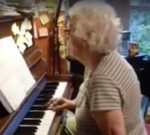The Adaptable Pianist: Purpose & Interest for the Elderly
 In 2017, seniors entering rehabilitation and assisted living centers have two distinct differences from those entering in previous years, 1) everyone has most likely learned to type, 2) everyone has access to a language of music that almost anyone with basic color & letter matching skills can easily and functionally comprehend.
In 2017, seniors entering rehabilitation and assisted living centers have two distinct differences from those entering in previous years, 1) everyone has most likely learned to type, 2) everyone has access to a language of music that almost anyone with basic color & letter matching skills can easily and functionally comprehend.
Typing requires stillness of body and hands so that specific signals can be sent from the brain to specific fingers to make quick, accurate strokes, followed by a litany of more tiny instructions (at this point, I’ve already struck 565 individual keys to type this passage). This skill requires ocular motion between an item that is straight ahead and an item that is positioned at torso level. With repetition, individuals develop muscle memory of small finger patterns that combine to a cohesive larger set of patterns which are hallmarks of advancement. Do any of these actions sound familiar piano teachers?!
Imagine if your students all came to you with the gross and fine motor skills already 75% ready. Then, imagine using a language of music in which people with the aforementioned basic matching skills are near instant experts. Fast forward a few weeks/months, and imagine the increased quality of life for someone in their 70’s, 80’s, or even 90’s when they independently play music for the first time!
At nearly 91, my mother is finding life difficult now because she has lost a good deal of her vision. She has never even touched a piano before and has had no musical training. I was at a loss as to what I could interest her in . . . and then I thought of Occupational Octaves. Although she can’t read the letters, she can see the colours (although the blue and green are difficult to distinguish from each other). This video came at the end of her very first half hour lesson. She really enjoyed it. So did I. (Sue Greenham)
As long as an individual’s basic matching skills are intact, almost anyone can immediately read a color coded language and begin cultivating the skills to actually turn these instructions into a piece of played music. Needed skills include pushing down on a specific key while hands are either hovering or still. Hands hover in specific places. Finger movements are distinct, prearranged, and purposeful. As skills are developed, more notes can be played with less attentional effort. Occupational Octaves Piano™ uses large colored letters, colorful rings on the fingers, and only 6 distinct colors. If you’d like to give it a try, please visit AllMusicInc.com For those of you working in a rehabilitation center, we provide a digital data based option, visit MundoPato.com/OccupationalOctaves